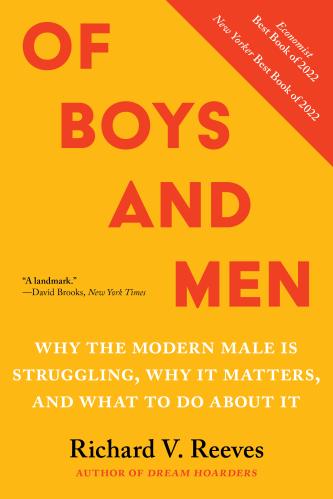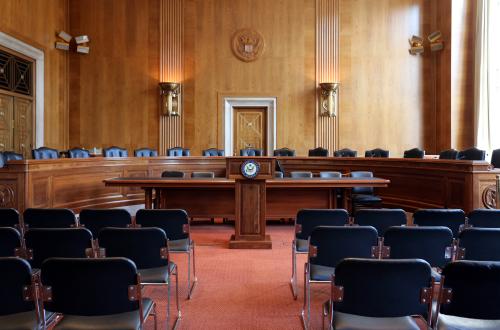Many boys and men are struggling. There is a strong case for government institutions that focus on the issues that are disproportionately impacting boys and men, and which can be usefully considered through a gender-specific lens. One attractive option is to create Commissions on Boys and Men, at the federal, state, and local levels. These would complement the ones that already exist in most states and many cities to work on issues related to women and girls.
Currently, there are no governmental commissions working on behalf of boys and men in any U.S. states. But a bill just filed in Washington state would create the first one. This could set an important precedent.
Why focus on Boys and Men?
In my latest book from Brookings Press, Of Boys and Men, and other related publications, I describe many of the challenges facing boys and men, especially those with least economic power. Important issues exist in the domains of education, employment, family life and health. There is a growing recognition that these problems need to be taken seriously, not only for the sake of boys and men, but also for the sake of women, children, the economy, and even the health of our political life. As Michelle Goldberg wrote in the New York Times, in response to my book:
“It’s possible to believe that sexism remains a major impediment to women’s flourishing and also believe that for many boys and men life is much harder than it should be. . . Even if you’re not inclined to care much about men’s welfare, their growing anomie and resentment is everyone’s problem, fueling right-wing populist movements around the world. People who feel unmoored and demeaned are going to be receptive to the idea that the natural order of things has been upended, the core claim of reactionary politics.”
Of course, it only makes sense to create institutions charged specifically with working on issues for boys and men if there is evidence of significant challenges that skew very strongly by gender. And there are. On a wide range of fronts, there are wide gender disparities disfavoring boys and men. For example:
Education
There are gender gaps at all levels of education, with boys and men trailing women and girls, often by wide margins. Black and low-income boys and men are falling farthest behind. Some of the headline statistics are:
- Girls are 14 percentage points more likely than boys to be “school ready” at age 5, controlling for parental characteristics.
- In the average school district, boys lag girls by three-quarters of a grade level in English (but are equally proficient in Math).
- Boys account for two thirds of high schoolers with the lowest grades, and a third of those with the highest grades (i.e., bottom decile and top decile).
- Male students are at a significantly higher risk of dropping out of college than women after taking into account other factors, such as test scores, family income, and high school grades.
- For every 100 bachelor’s degrees awarded to women, just 74 are awarded to men. (This is a wider gender gap than in 1972, when Title IX was passed – but the other way round).
- These disparities vary by place, with wider gaps at different stages of the education system in different places. For more, see my paper with Ember Smith, “Boys left behind: Education gender gaps across the US”.
Work & Wages
There are long-standing concerns about declining male labor participation from policymakers and scholars of all political stripes: for example from Harvard’s Jason Furman, former Director of the National Economic Council under President Obama, and Nicholas Eberstadt, Senior Fellow at the American Enterprise Institute. These worries are being rekindled now with signs that some groups of men, especially those of middle age, are not returning to the labor force as quickly as expected following the pandemic.
Some of the headline statistics on men’s work and wage are:
- In early 2022, more than one in ten prime-age men (25-54) were neither working nor looking for work.
- The inflation-adjusted wages of most men in 2019 were lower than the wages of most men in 1979.
- The wages of a typical American man who completed his education with a high school diploma were 14% lower in 2019 than in 1979.
- “Essentially all of the income gains that middle-class American families have experienced since 1970 are due to the rise in women’s earnings”, according to the Council of Economic Advisors.
- Men who entered the workforce in 1983 will earn about 10% less, in real terms, across their working life than those who started out in 1967.
As I argue in Of Boys and Men, male employment has not fallen because men have suddenly become feckless or work-shy, but because of shifts in the structure of the economy. Male jobs have been hit by a one-two punch of automation and free trade.
Family & Fatherhood
Family life has been transformed in recent decades. Many fathers do not have a positive role in their children’s lives. Some of the important facts and trends here include:
- Forty percent of children are born outside marriage, up from 11% in 1970, with especially high rates among parents with less education.
- Among fathers who did not complete high school, 40% live apart from their children, compared to just 7% of fathers who graduated from college.
- Within 6 years of their parents separating, one in three children never see their father, and a similar proportion see him once a month or less.
- Father presence in the home for adolescent boys is associated with a 5.1 percentage point decrease in the likelihood of engaging in delinquent behavior compared to those without a father figure.
- Helping fathers to be engaged in their children’s lives is an important goal for policymakers, especially given profound changes in family life. I argue in Of Boys and Men that what matters most is not the marital status of parents, but the relationship between parents and children.
Mental and physical health
Poor health reflects and reinforces many of the trends described above, and there are some health challenges that particularly impact men. For example:
- Nationally, boys and men are at four times higher risk of suicide than girls and women.
- Male suicide rates rose by 25% from 2006 to 2019.
- Men account for 71% of deaths from opioid overdoses.
- Men were at a much higher risk of death from COVID-19: so far 110,000 more men than women in the U.S. (without age adjustments) have died from the virus.
- Men are 31% more likely than women to be without health insurance (13.8% v. 10.5% of the nonelderly). In many states the gap is much wider. (In Tennessee, for example, 17.4% of men are uninsured compared to 12.4% of women, a 40% gap).
This is not of course intended to be a comprehensive list. Importantly, the extent of these problems varies greatly by social class and by race, with Black boys and men at a particular disadvantage. But also, by place: In different cities, counties and states, boys and men will have different challenges. So, it is likely to be valuable to have Commissions for boys and men at these levels of government – just as there are for women and girls.
Washington State could lead the way
A bill to create a Commission on Boys and Men has just been pre-filed in Washington state, with bipartisan sponsorship. The new Commission would be “tasked with addressing the well-being of Washington’s boys, male youth, and men.” Supporters hope the bill will be brought up by the State Government & Tribal Relations Committee for consideration in the new legislative session. If the bill is passed, it will create the first state-wide Commission on Boys and Men in the nation.
The bill as it stands includes an initial mandate to focus on five areas in particular:
- Education
- Fatherhood, Family, & Relationships
- Jobs, Careers, & Financial Health
- Mental & Physical Health
- Experiences of Males in Criminal Justice and other Court Systems
Of course, the bill may be amended. But these seem like the right focus areas based on current trends, not only in the U.S. but in Washington state. The case for the new Commission is strengthened by some key facts and trends in the Evergreen state, including:
- Across grades 4 to 8 in the state, boys are a full grade level behind girls in English (and slightly ahead in Math). Seattle has the second-highest gender gap in English among the 25 largest cities in the U.S.
- Only 49% of boys are meeting expected standard in English in middle school grades, compared to 60% of girls.
- Boys account for 75% of school suspensions.
- Between 2018 and 2021, men accounted for 67 percent of drug overdose deaths.
- Men and boys account for 77% of suicide deaths in the state.
- Nine in ten (91%) of inmates in juvenile rehabilitation facilities are male.
The bill also proposes that the new commission be “tasked with developing strategies to encourage men and male youth to consider careers in teaching, mental health care, social work, nursing, and other professions where the workforce severely lacks male participation.” This is a goal that is often overlooked by policymakers. It is vitally important to get more men into HEAL professions (in health, education, administration, and literacy), not only to help meet the need in those occupations but to provide better services in these fields for boys and men. This is an argument my colleague Isabel Sawhill and I made in the New York Times in 2015, in an essay headlined “Men’s Lib.”
In Washington state, only one in four K-12 teachers are men (26%), similar to the national share. Just over one in three psychologists in the state are male (37%), and men accounted for 23% of the doctoral degrees awarded in the state in 2015 (and these are a requirement for professional practice). Only 18% of social workers are male – and just 15% of students who received a master’s in social work in the state in 2015 were men.
Learning from Commissions on Women and Girls
It is not necessary to start from scratch. Good models for any potential Commission on Boys and Men are provided by the existing ones for women and girls. That includes the Washington state Women’s Commission, which was created in 2018 to “address issues relevant to the problems and needs of women, such as domestic violence, childcare and support, sexual discrimination and harassment in the workplace, equal compensation and job pathways in employment, and the specific needs of women of color.”
The Washington state Women’s Commission has nine external commissioners and four legislative advisors, a staff of two, and a budget of around $250,000. The Executive Director sits in the state cabinet. The Commission has established committees to work on four priorities for women in the state: Economic Opportunity, Economic Security, Safety and Health. The Commission describes its main activities as Legislative Advocacy; Information Gathering and Research; Public & Private Partnerships; Community Outreach; and Resource Referral.
The proposed Commission on Boys and Men in the state would have a similar governance structure, with nine voting members, appointed by the governor and leaders from both sides of the aisle in the legislature, and two members of both the state senate and house of representatives (from both parties) serving in an advisory capacity.
There are similar Commissions for women and girls in most other states. Out of the 50 U.S. states plus the District of Columbia, 39 currently have a statutory body focused on women’s issues. (See the Appendix Table for a full list plus links). These Commissions vary in their scope, name, resources, specific areas of focus, and position within the state government hierarchy. The California Commission on the Status of Women and Girls is comprised of seventeen members, with “nine Public Members, six Legislative Members and two Statutory Members”, and has a staff of seven. Utah’s commission has 13 members, including legislators, administrators and external stakeholders. The Illinois Council on Women and Girls is unusually large, with 32 members including 16 appointed by legislators and key department heads. While the specifics vary state by state, the majority of Commissions have the following core tasks:
- Publishing an annual report on the condition of women (and girls) in the state, with key facts and trends on employment, health, family life, education, domestic violence, and leadership.
- Advising policymakers (typically both the Governor and state legislators) on programs, policies and initiatives that impact women and girls. Advocating for policies and programs that will improve the lives and life chances of women and girls in the state.
- Convening key stakeholders, including businesses, community leaders and non-profits to address critical issues for women and girls.
Many major cities also have a Commission on women and girls, including in some of the states without a state-level body. For example in Arizona there are Commissions in Phoenix and Tucson and in Colorado, there are Commissions in Denver and Fort Collins.
In North Carolina, as well as the state Commission, there are commissions for women in five cities and counties in the state. In California, according to the Association of California Commissions for Women and the National Association of Commissions for Women, there are women’s commissions in all the major cities and counties in the state. Policymakers in these cities ought to consider a similar Commission on boys and men.
It is necessarily hard to measure the impact of these Commissions, not least because a significant part of their role is simply to raise awareness and highlight existing resources. But it seems clear that they do have some influence on policy. From 2018 to 2022, the Washington state Women’s Commission, for example, worked with a legal firm to create template workplace policies on sexual harassment, which are now freely available to employers; advocated to increase the share of women on company boards, including by publishing data on board diversity for all major firms in the state; and championed a new law to improve childcare provision.
Is it Time for Commissions for Boys and Men?
As far I have been able to discover, there are almost no equivalent bodies for boys and men in any state, city, or county government. Nor are there any at the federal level. The only exception is the DC Mayor’s Office on Fathers, Men and Boys which grew out of a commission and serves some of the same functions. The Office describes its role as being to “address the disparities that adversely impact men and boys of color in the District of Columbia”. The Office is a successor to the 21-member Commission on Fathers, Men and Boys, created in 2014 “to advise the Mayor, the Council, and the public on issues and needs of fathers, men, and boys in the District”.
Any new Commissions working for boys and men will likely work closely with the existing ones for women and girls on a number of fronts, not least family policy. The two commissions should be seen as complementary counterparts, not competitors. As I write in Of Boys and Men:
“We can hold two thoughts in our head at once. We can be passionate about women’s rights and compassionate toward vulnerable boys and men…It is not a zero-sum game.”
Or as Jason Furman puts it (in a review of the book):
“To say there are a set of problems faced by boys and men that need a policy solution, does not mean that you don’t think there are a set of problems facing girls and women that need a policy solution.”
In many cases, these policy solutions will be arrived at when they are productively examined through a gender lens. This includes boys and men. Time to institutionalize that insight.
Click here to download the appendix.
The Brookings Institution is financed through the support of a diverse array of foundations, corporations, governments, individuals, as well as an endowment. A list of donors can be found in our annual reports published online here. The findings, interpretations, and conclusions in this report are solely those of its author(s) and are not influenced by any donation.
The Brookings Institution is committed to quality, independence, and impact.
We are supported by a diverse array of funders. In line with our values and policies, each Brookings publication represents the sole views of its author(s).








Commentary
The case for a Commission on Boys and Men: Will Washington state lead the way?
January 13, 2023